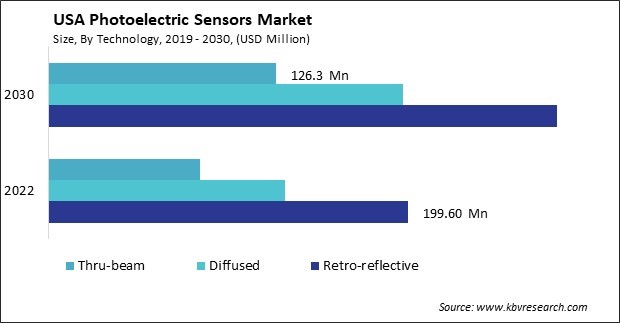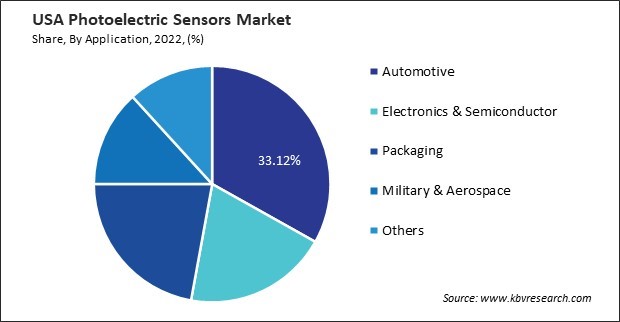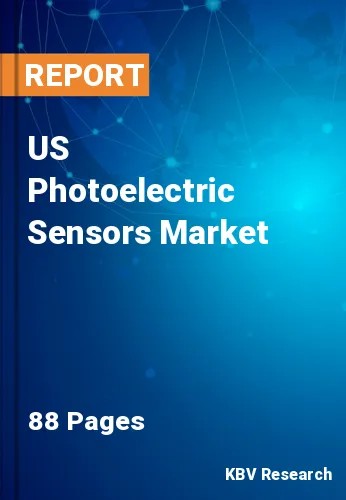The USA Photoelectric Sensors Market size is expected to reach $605.1 million by 2030, rising at a market growth of 4.9% CAGR during the forecast period. In the year 2022, the market attained a volume of 8,242.8 thousand units, experiencing a growth of 4.9% (2019-2022).
The United States has become a key player in the global industry for photoelectric sensors, driven by its robust industrial base and technological advancements. Industries such as electronics, automotive, and pharmaceuticals in the U.S. rely heavily on photoelectric sensors for many applications, including object detection, counting, and positioning. This industry's steady growth indicates the widespread adoption of these sensors across various sectors.

A notable trend in the U.S. photoelectric sensors market is the integration of these sensors with the Internet of Things (IoT) and Industry 4.0 initiatives. This integration has ushered in a new era of connectivity and automation, enhancing the efficiency and capabilities of industrial processes. Beyond traditional industrial applications, photoelectric sensors are making inroads into consumer electronics, healthcare, and smart infrastructure projects, showcasing their versatility, and expanding industry reach.
Energy efficiency and sustainability concerns are further propelling the adoption of the photoelectric sensors market in the U.S. industrial landscape. As industries seek to optimize resource utilization and embrace environmentally friendly practices, these sensors offer a viable solution. The availability of cost-effective options has democratized access to photoelectric sensors, enabling various industries to benefit from their functionalities and contributing to the overall industry expansion.
Safety applications represent another significant dimension of the photoelectric sensors market in the U.S. These sensors are crucial in industrial settings for ensuring the safety of workers and equipment through presence detection. The Occupational Safety and Health Administration stated that in 2020, 4,764 workers lost their lives (3.4 per 100,000 full-time equivalent workers). A total of 1,282 and 976 workplace deaths, or nearly half of all fatal occupational injuries (47.4%), were caused by workers in the transportation and material moving and construction and extraction industries, respectively.
The impact of occupational fatalities, particularly in high-risk sectors such as transportation, material moving occupations, and construction, can influence the demand for various safety technologies, including photoelectric sensors. The outlook for the photoelectric sensors market in the U.S. is optimistic. Continued innovation in sensor technologies, coupled with the expansion of applications in emerging sectors, is expected to sustain the growth trajectory.
The demand for retro-reflective sensors in the United States is propelled by factors reflecting their versatile applications and significance in various industries. In the manufacturing and logistics sectors, retro-reflective sensors play a pivotal role. These sensors are adept at detecting the presence of objects on conveyor belts, ensuring proper alignment, and facilitating the seamless flow of materials.
Integrating retro-reflective sensors into automated systems and robotics fuels their demand. These sensors provide real-time feedback essential for precise control and navigation, enhancing the overall efficiency of automated processes. In the packaging industry, retro-reflective sensors are employed for tasks like label placement and package counting, contributing to optimizing packaging processes. Thus, the versatile applications of retro-reflective sensors in the U.S., particularly in manufacturing, logistics, and automation, underscore their pivotal role in streamlining operations and enhancing efficiency.
According to the National Institute of Standards and Technology (NIST), in terms of value-added, the primary measure of economic activity, the U.S. is the second largest manufacturing nation in the world. In 2022, manufacturing contributed $2.3 trillion to U.S. GDP, amounting to 11.4 % of total U.S. GDP, measured in chained 2012 dollars. The same source stated that the U.S. ranks 10th among 49 countries in Statistica’s Made-in-Country Index. Likewise, the nation ranks 8th in the Ipsos National Brands Index. As these sensors evolve to meet the changing needs of industries, they will likely remain integral components in the landscape of automation, safety, and efficiency in the United States.
Converging photoelectric sensors with IoT and Industry 4.0 technologies enhances their functionality, provides real-time data insights, and contributes to more intelligent and efficient industrial processes. One major catalyst is the pursuit of enhanced efficiency and productivity gains across diverse industries. IoT and Industry 4.0 technologies facilitate the integration and automation of processes, creating interconnected ecosystems where machines, devices, and systems collaborate seamlessly.
Government initiatives and support also contribute to the expansion of these technologies. Programs aimed at fostering innovation, research, and development and the adoption of Industry 4.0 technologies provide incentives for businesses to invest in these solutions. Government support catalyzes the acceleration of adopting advanced manufacturing technologies, fostering economic growth, and positioning the US as a leader in the global technology landscape.
For example, the AMTech program, under the National Institute of Standards and Technology (NIST), provides funding for public-private partnerships focused on addressing challenges in advanced manufacturing. These partnerships often involve developing and implementing IoT and Industry 4.0 technologies. Thus, the demand for these sensors will likely grow as industries increasingly recognize the value of connected and intelligent sensor solutions in driving efficiency, productivity, and competitiveness.

In the United States, several companies specialize in the manufacturing and provision of photoelectric sensors, contributing to the growing demand for these devices across various industries. One prominent player in this space is Banner Engineering, a company known for its comprehensive range of sensor solutions. Banner Engineering designs and manufactures a variety of photoelectric sensors catering to diverse applications, such as object detection, distance measurement, and quality control.
Keyence Corporation and Omron Corporation are prominent players in the US photoelectric sensors market, offering a comprehensive range of automation and sensing technologies focusing on photoelectric sensors. Keyence's extensive portfolio and Omron's global recognition highlight their significant presence in the evolving landscape of industrial automation in the United States.
Rockwell Automation, a leader in industrial automation and information technology, stands out as a key player with diverse solutions, including photoelectric sensors. Their offerings contribute to efficient and intelligent manufacturing processes, aligning with the growing integration of automation technologies in various industries across the US.
Autonics USA, Inc. and Baumer Group further contribute to the competitive landscape by providing automation solutions, including precision-designed photoelectric sensors. Autonics emphasizes reliability in applications such as packaging and material handling. At the same time, Baumer Group's global expertise extends to the US, offering innovative sensor solutions that enhance the efficiency and automation of manufacturing processes.
Together, these companies exemplify the diversity and competitiveness of the US photoelectric sensors market. Their continuous innovation and development efforts underscore the crucial role of photoelectric sensors in advancing industrial automation and fostering the widespread adoption of Industry 4.0 principles in the dynamic landscape of the United States.
By Technology
By Application
Our team of dedicated experts can provide you with attractive expansion opportunities for your business.

